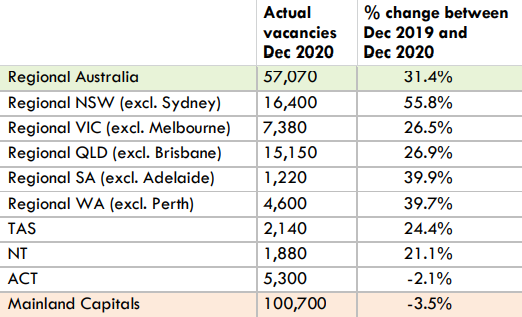By Chief Economist, Dr Kim Houghton
Job vacancies
In December 2020 there were over 54,000 jobs advertised on the internet across Regional Australia. Regional vacancy recovery has been much faster (up 71% on May 2020) than capital cities, particularly the east coast capitals which are still 22-25% below their May 2020 levels.
December regional vacancies were slightly below the November peak of 57,000. However, there is always a seasonal fall over the holiday period, and this year it was much less than in previous years. In seasonally-adjusted terms, job vacancies Australia-wide actually increased in the month to December by 1.4%.
December 2020 regional vacancies were a huge 30% above where they were a year before in December 2019. Regional job vacancies have risen steadily since the low point in April 2020. This internet vacancy series is a three-month average, so the figures soften the month to month volatility in employers taking the time to advertise vacancies.
The December data highlights the continuing significant differences between regions as they emerge from the COVID-19 restrictions. Most regions are now seeing more vacancies advertised in December 2020 than there were in December 2019. Standout vacancy growth is seen in Dubbo and Western NSW which had over 1,300 vacancies advertised in December 2020, up 100% on the 650 vacancies in December 2019. Other regions showing growth were North Coast (NSW), Tamworth (NSW) and Southwest WA, each with vacancies last month around 60-75% higher than a year ago.
In December 2020, jobs in most demand in Regional Australia continued to be well-paid mid- to high-skilled professionals and trades jobs. These two occupations accounted for over 50% of all advertised vacancies. But looking at growth rates, lower-skilled vacancies are leading. Vacancies for Sales Workers, Labourers and Community & Personal Services workers are up over 50-60% on December 2019 levels in Regional Australia, while the higher skilled professions and trade vacancies were 12-30% above their levels last year. Regional employers are clearly looking to hire more ‘feet on the ground’ in these fundamental roles.

The December 2020 trends indicate that Regional NSW is showing the fastest recovery – with the number of vacancies up over 50% on December 2019. While Regional Victoria’s vacancy numbers were lagging due the second lockdown, they have now caught up with the regional areas in other states which are now all in the range of 25-40% above December 2019 levels.
